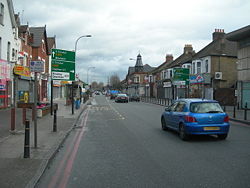Catford Gyratory
| Catford Gyratory | |||
| Location Map ( geo) | |||
 | |||
| Brownhill Road, forming the north side of the gyratory system | |||
| |||
| Location | |||
| Catford, South London | |||
| County | |||
| Kent | |||
| Highway Authority | |||
| Transport for London | |||
| Junction Type | |||
| Gyratory | |||
| Roads Joined | |||
| A21, A205 | |||
Probably one of the more well-known and best-avoided trouble spots on the frankly diabolical A205 South Circular Road, the Catford Gyratory is a deceptively simple junction where the A205 crosses the non-primary A21, and on the face it, the whole thing should be straightforward and unproblematic - especially when seen in the context of some of the other tangled, maddening multiple-road junctions that the bedraggled A205 is pushed through elsewhere on its route.
The Catford Gyratory itself is indeed very simple as these things go. Seven single-carriageway roads approach it. Running clockwise from the north, these are:
- A21 Rushey Green: the road from Catford to Lewisham
- A205 Brownhills Road: the South Circular Road eastwards towards the A20
- Engleheart Road: a residential street that runs one-way, which can only remove traffic from the gyratory
- Sangley Road: another residential street
- A21 Bromley Road: the main road south from Catford
- A205 Catford Road: the South Circular Road west towards the A23
- Catford Broadway: a short shopping street, one-way and largely pedestrianised, which can again only remove traffic
The gyratory itself is formed of existing streets in Catford town centre, which leaves the shopping district fragmented and rather unpleasant to visit on foot as a result. In traffic terms it is not particularly bad as South London town centres go: a one-way box is formed around which traffic circulates, though it is complicated by a contraflow bus facility that allows local buses to travel south on the western side of the circuit. All entrance points to the junction are controlled by traffic signals.
In fact the gyratory itself tends to handle traffic without too many problems, and the real hold-up is immediately to the west on the A205. The bottleneck section between Catford and the A212 junction causes queues in all directions; for eastbound traffic this results in a delay to reach the junction, which clears just before the gyratory; for westbound traffic the queue stretches back on to the south side of the one-way system but is not actually caused by the gyratory itself.
It may well be the case, of course, that the section of A205 immediately to the west has a lower capacity than the gyratory and is effectively metering the traffic flow through the junction, and that the gyratory itself can only cope with traffic volumes because the flow of traffic into it has been restricted in this way.
Plans existed until the 1990s to 'fix' Catford and dual the South Circular here; reserved land is visible within the gyratory on the north side of Sangley Road and in open land east of Canadian Avenue for this scheme. It has since been dropped and there are no current plans to improve the junction.
West of the Gyratory
The problematic section of A205 west of the Catford Gyratory has several shortcomings.
There are, for example, many minor side-turnings and accesses to streets and premises that, on other similar London major roads, would have been restricted in some way by now - by making them one-way or by banning certain turns into or out of them to reduce traffic conflicts and vehicles waiting on the A205. This is not the case here, as - particuarly with access to premises and the railway stations - there is no alternative means of access.
The width of the road is also highly inconsistent. It reduces to one lane in each direction under the railway bridge near Stanstead Road and immediately east of the gyratory, but in between, widens out to dual carriageway, causing multiple avoidable merge points in each direction where traffic queues up as it waits to enter the one-lane sections.
Finally, the A212 junction is oddly laid out, with a triangular arrangement of two-way roads with many redundant movements still permitted through the junctions, causing overly long traffic light cycles and hence further queues in all directions.
Routes
| Route | To | Notes |
| Clapham Junction | ||
| Woolwich | ||
| Central London, Lewisham | ||
| Bromley, Downham |




